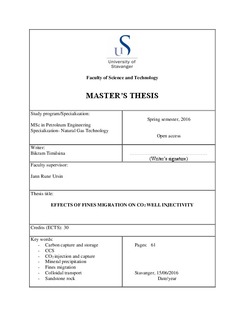| dc.contributor.advisor | Ursin, Jann Rune | |
| dc.contributor.author | Timilsina, Bikram | |
| dc.date.accessioned | 2016-09-21T09:13:48Z | |
| dc.date.available | 2016-09-21T09:13:48Z | |
| dc.date.issued | 2016-06-15 | |
| dc.identifier.uri | http://hdl.handle.net/11250/2409143 | |
| dc.description | Master's thesis in Petroleum engineering | nb_NO |
| dc.description.abstract | Carbon capture and storage is considered an important way to reduce atmospheric emission of greenhouse gases such as CO2. This technology involves capture of carbon from the source of emission, transportation to storage sites and then injection into the suitable formations, oceans and other storage options.
This paper is focused on injectivity issues related to injection of supercritical CO2 into the formation. When CO2 is injected into sandstone, interaction between the injected CO2, formation brine and the rock minerals, generate fine particles inside this porous media which could affect the injection process. This paper recognizes mineral dissolution as the source of fines inside the porous media. Interaction of CO2, formation water and rock under suitable range of temperature and pressure is cause of mineral dissolution. During CO2 reinjection, the injected fluid could transport these fine particles into the porous media. The transported fines could bridge pore channels and consequently reduce rock permeability and hence CO2 injectivity. Unfortunately, this phenomenon have not been well studied experimentally.
Based on literature research, the estimated amount of calcite precipitation after 100 days of CO2 storage was found. Necessary calculations were done to inject same concentration of alumina particles into Berea sandstone core. After particle injection, CO2 injection was done and permeability of the core was measured. In this way, laboratory approximation of CO2 reinjection after 100 days was constructed. Significant reduction in permeability was recorded in the presence of particles.
After this, alternate brine and CO2 injection was performed in the same core to see if brine could push fine particles out of the core and improve permeability of the core. However, there was no significant improvement in permeability after this alternate injection.
Another experiment was conducted to see the effect of salt precipitation inside the core. This experiment did not involve injection of particles. However, very high salinity of NaCl brine was injected and vaporized with dry CO2 and then permeability was measured. Brine experiment also showed significant decline in permeability. Permeability improved when concentration of brine was reduced. | nb_NO |
| dc.language.iso | eng | nb_NO |
| dc.publisher | University of Stavanger, Norway | nb_NO |
| dc.relation.ispartofseries | Masteroppgave/UIS-TN-IPT/2016; | |
| dc.subject | CCS | nb_NO |
| dc.subject | CO2 injection and capture | nb_NO |
| dc.subject | petroleumsteknologi | nb_NO |
| dc.subject | petroleum engineering | nb_NO |
| dc.subject | carbon capture and storage | nb_NO |
| dc.subject | mineral precipitation | nb_NO |
| dc.subject | fines migration | nb_NO |
| dc.subject | colloidal transport | nb_NO |
| dc.subject | sandstone rock | nb_NO |
| dc.subject | natural gas technology | nb_NO |
| dc.title | Effects of fines migration on CO2 well injectivity | nb_NO |
| dc.type | Master thesis | nb_NO |
| dc.subject.nsi | VDP::Technology: 500::Rock and petroleum disciplines: 510::Petroleum engineering: 512 | nb_NO |
